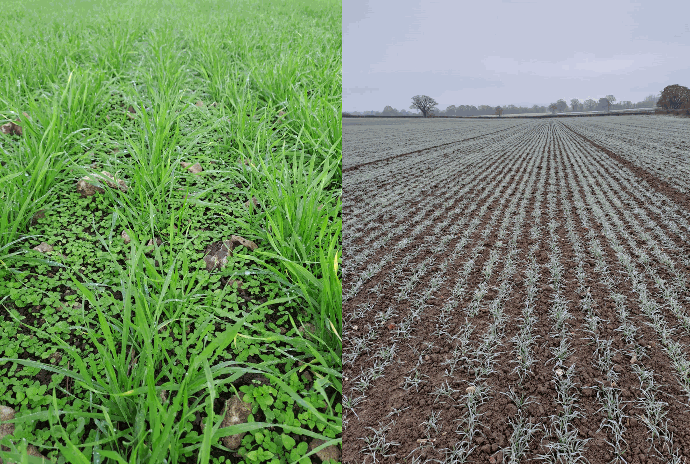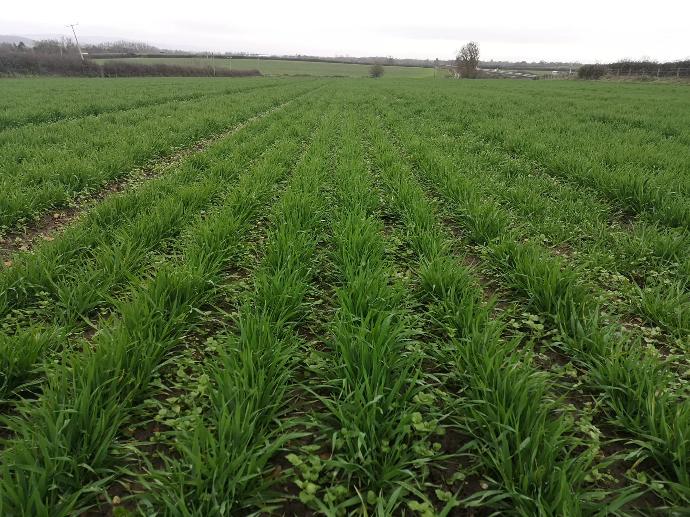At times it feels like every crop management decision in organic farming is a trade-off, but without knowing in which direction the balance may swing. Inspired by recent farm visits and discussions with members I wanted to raise this topic as now is a good time of year to assess the merits and drawbacks of each approach
The orthodoxy is that Organic crops should be drilled mid-October, balancing the opportunity to get in cultivations and weed strikes, with the shorter days, colder temperatures and the shorter growing season. The climate crisis is forcing some farmers to consider early drilling and many may now feel they have the confidence and the right varieties to be able to drill early. This Autumn in particular has shown why drilling earlier could be a sensible approach to spread risk and get seeds in the ground ahead of bad weather and saturated soils.
Reasons why a early/mid-October drilling date is common practice is due to the lower weed pressure, a lower disease pressure, lower pest pressure and avoidance of the crop being too "proud" over winter. It may be time for us to challenge some of these conceptions. The longer the crop is in the ground, the longer each development stage, and the benefit to building biomass and yield.

Perhaps an early/mid-September drilling could be a very useful option for some. Soil temperatures are warmer and light intensity higher with longer days, enabling crops to grow quickly and put on a lot of biomass. Of course weeds will also prosper in these conditions without opportunities for stale seed beds. So here is the main trade-off...healthy vigourous crops with higher numbers of weeds and stronger growth. However, many that germinate early are relatively benign and the kind of community you may see will include speedwells, chickweed, meadow grass and red dead-nettle. This benign community will grow prostrate, covering the ground and offering limited competition with the crop. One agroecological service a benign weed community offers is some control of more pernicious weeds and other later germinating weeds. Early drilling may also allow for more of an opportunity to get a weed strike in, post-emergence. In respect to disease and being too proud, It think the risk from these issues may be exaggerated, and with a judicious grazing off with sheep, both can be managed. In fact, for those wishing for a little extra winter bite for their sheep, more crop biomass would be of benefit. The main question is, can vigourous crops suppressive a greater population of weeds that will also grow vigourously? The honest is I don't know. In some situations yes, in others no. The weather, soil and weed community will all play their part, but appropriate variety choice will also being important, looking for fast growing, vigourous cultivars that will offer the most competition against weeds. The winter wheat Extase is a very good example of and some spring crops, planted in Autumn will also exhibit strong early vigour. For Organic farming these traits are important no matter the drilling date, but may be even more crucial in environments with higher early disease pressure.

Crops drilled later are often relatively free of annual weeds, and usually get a good head start on weeds, but all things being equal, yield potential will always be lower. The information we really need is how the two approaches compare across several seasons, say over three or four to know which is the lower risk option with the greatest reward. Perhaps in years when later drilling is favoured, early drilling performs very poorly, but in years where early drilling would have been the best option, later drilling performed only marginally worse, and one year neither approach was favoured, meaning over three years, later drilling would be the better strategy. This is exactly the sort of question and research we should be conducting as a community to find answers and make improvements to organic crop production.
Very interested in all your thoughts on this so please get in touch to discuss further. dominic@organicarable.co.uk
This is exactly the sort of discussion that we would like to facilitate on our forum (in development) as we try to improve the sense of community by trying to connect you to each other.